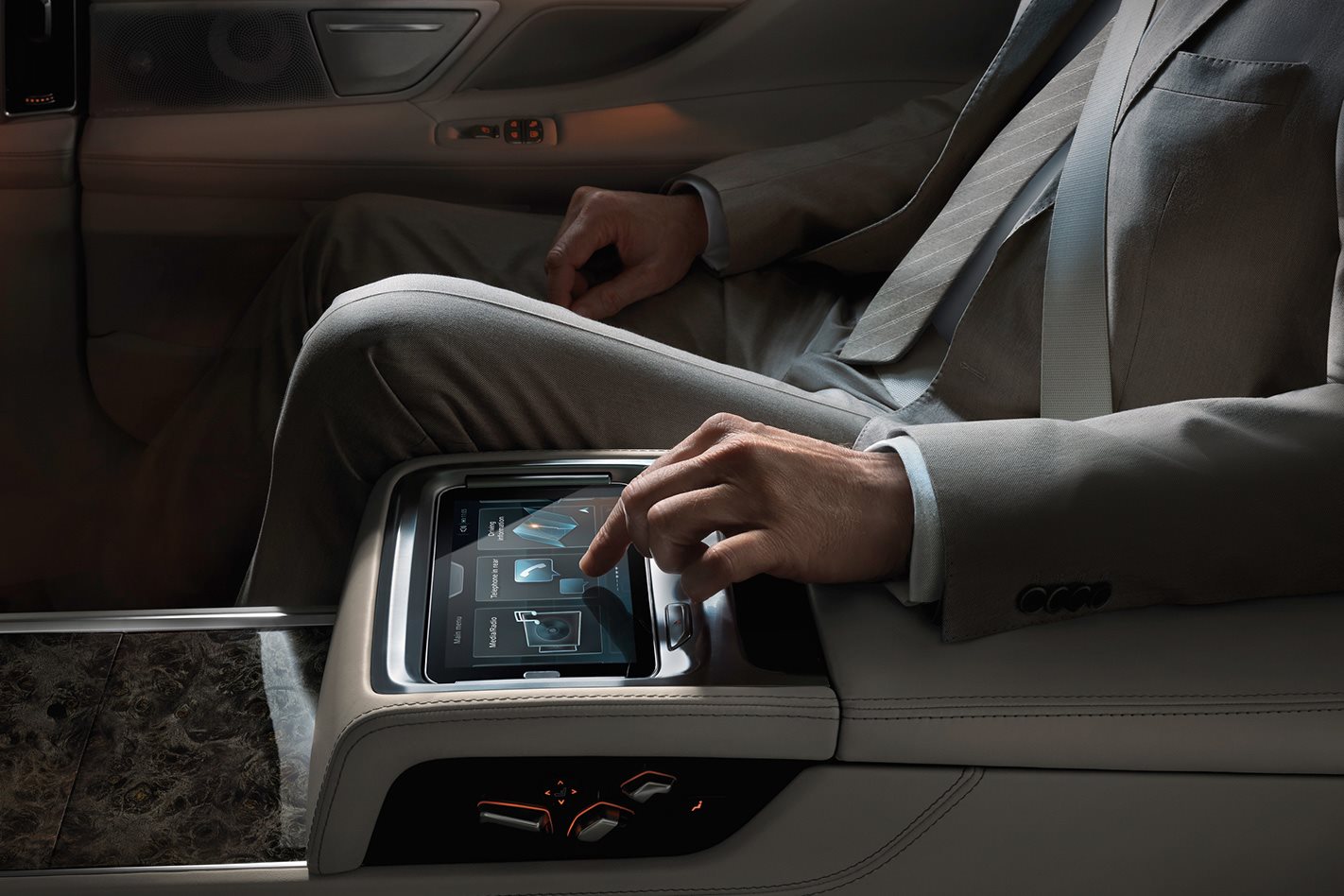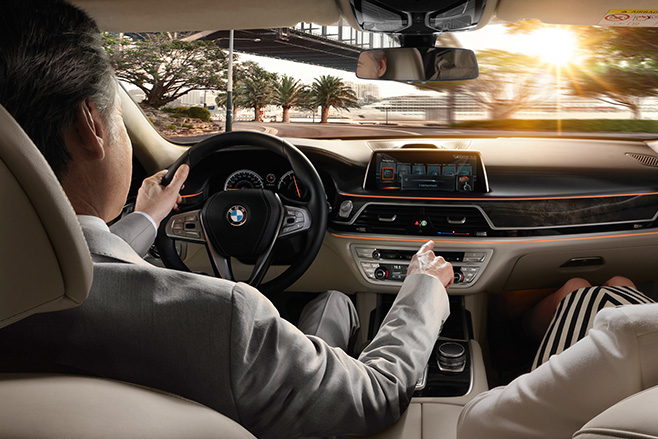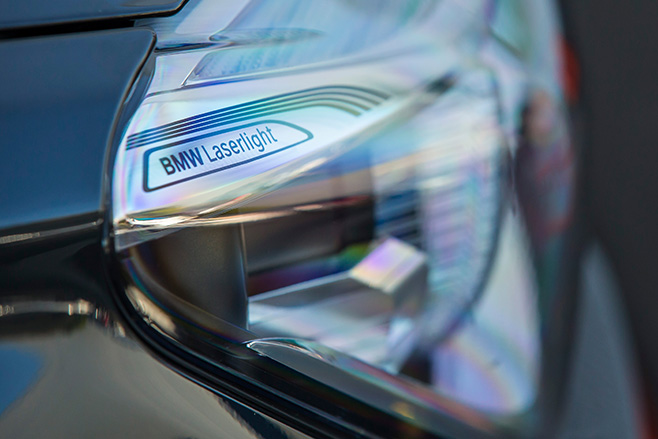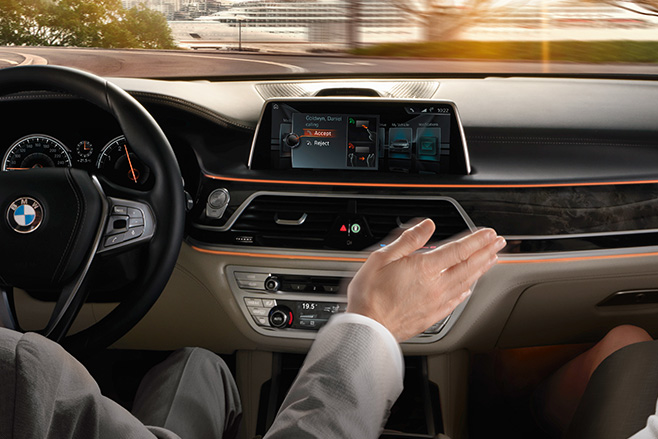
You don’t realise how mundane and annoying some common tasks are until technology comes along and makes them redundant. In the near future we will no doubt look back on the days when we had to press buttons and twiddle dials in our cars, and shake our heads in wonder at how we ever had the time and energy. Fortunately, vehicles like BMW’s 7 Series are paving the way in new technologies to ensure driving-tasks become autonomous.
GESTURE CONTROL
If you haven’t driven a new BMW 7 Series yet, you probably don’t realise just how cumbersome and time-consuming volume knobs are.
BMW, which boldly claims that its new luxury limo barge is “the most technologically advanced car on the road today” has introduced Gesture Control to solve this problem.
People will be thrilled to simply twiddle a finger in the air to control radio volume, or pinch a piece of air to spin a 3D view of the 7 Series to show every angle of a parking dilemma. Then there’s always the ability to answer calls with a “come hither” wave in the air, or reject them with a dismissive flick.
There’s even a Vulcan Greeting hand movement option, which you can program to do whatever you like; set the satnav to find the nearest bottle shop, turn on the car’s incredible massage seats, which feel like they’re made out of disembodied Thai ladies’ hands, or change the mood lighting (or scent) in the cabin.
Yes, the 7 Series still offers you buttons to do all these things, and the world’s first integrated tablet (a Samsung because Apple was busy building its own Car of The Future) for the rear passenger which can operate plenty of functions as well, but Gesture Control is clearly going to impress your friends, and baffle other motorists at traffic lights.

Pointless or pointy end?
In all honesty, it is easier just to set the volume using the buttons, and the whole thing feels slightly gimmicky, but the phone function is great and it’s still a safe bet that other car companies will be working on this kind of system. Should be either very popular or entirely baffling in hand-waving Italy in particular.
REALLY SMART KEYS
It is genuinely possible to fall in love with the new 7 Series without getting in it, particularly if you’re a geek, because its epoch-shifting Display Key is just so lovely.
Looking a lot like a small smart phone, this innovative key offers a choice of colour screens you can flick through, which allow you to check your range, work out when your next service is due, confirm that you locked the doors when you left it and even “pre-condition” the interior by choosing a temperature and turning on the air-conditioning before you arrive.
It looks, feels and works like a dream and is one of those inventions that you just can’t believe has taken this long to eventuate. On the downside, it’s yet another thing in your life you’ll have to keep charged (although it still opens the doors even if the screen’s gone dark).

Pointless or pointy end?
Make no mistake, your car will eventually have a key like this, although possibly not quite as pretty, because it’s an idea that will so clearly appeal to all of us now that touch screens are a kind of minimal requirement for life in the western world. Apparently many small children now walk up to their giant TVs, not to change the channel but because they expect to be able to manipulate the screen by hand. The Display Key is a genuine game changer.
LASER LIGHTS
Not quite as impressive as they sound – if you’re picturing something Star Wars-esque, just stop now – these new-tech headlights are still fairly mind-boggling.
Laser Lights, which are optional on all but the very top-spec 7 Series, don’t so much improve your high-beam coverage as reinvent it, doubling their effective distance from 300m to 600m. And doing so with the kind of bright, white light that turns night into day. They also track the motion of your vehicle and your hands on the steering wheel, in such a way that they seem to look around corners at night even before you do.

Pointless or pointy end?
Very much at the pointy end, and coming to a car near you – eventually. LED lights look fantastic and work brilliantly, but they’re still a lot more expensive than old-tech. You can still expect them to trickle down to cheaper BMWs, and eventually normal cars as well.
AUTONOMOUS STEERING
BMW’s new 7 Series isn’t quite a self-driving car, but it’s definitely an important pit stop on the journey to the seemingly inevitable human-free future of motoring.
Steering and Lane Control is described as a “semi-autonomous” system, which means you’re meant to still keep your hands on the wheel, and your eyes on the road, while it’s operating. Basically, it does steer for you as you can see by taking your hands off completely for the 10 seconds the system allows you to do so, before beeping and flashing at lights to remind you that you’re at least supposed to pretend you’re in control.
The system uses several cameras and radars to read road markings and examine the behaviour of cars in front of you, and then cross matches its data with satellite maps and GPS information, and basically steers you around bends.
BMW says the system works best on freeways and is, when used in conjunction with Active Cruise Control, a way of making a Sydney to Melbourne slog, for example, a less tiring exercise because you basically sit there and let the car do all the work.
In practice, it’s a little bit scary, and can occasionally get a bit dopey, just like a human, but you can see where the technology is going and it’s hard not to be impressed, and a little depressed if you enjoy driving.

Pointless or pointy end?
Very much at the pointy end, and very much the way all cars are heading. Your car won’t drive itself next year, or possibly even next decade, but by 2030…
SUSPENSION OF DISBELIEF
A car that sees bumps in the road before you do almost sounds too incredible to be true, but the new BMW 750i comes with a standard system called Executive Drive Pro (a hefty $5000 option on lesser models), which is described as an active electromechanical roll stabilisation system. What this means is that it provides a super-smooth ride over any surface because it can see bumps coming and prepare its suspension to react.
Executive Drive Pro uses cameras to scan the road ahead for potholes and bumps and pre-adjusts the car’s dampers to prepare for the impact in milliseconds. The result is a level of comfort and ride quality previously only seen on Rolls-Royces (a company owned by BMW, funnily enough). The kind of computing power involved would make the Apollo missions to the moon look like people fooling around with an abacus.
Pointless or pointy end?
This is the kind of technology that could be making all cars feel smoother and more pleasant to drive – if only it wasn’t so incredibly expensive to produce and fit to vehicles. It will become commonplace one day, no doubt, but that day is still some way off.



